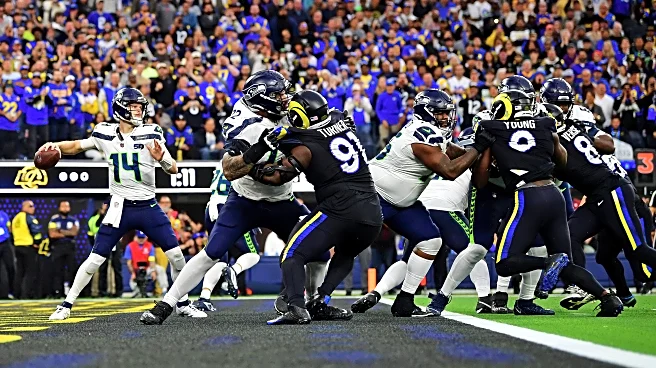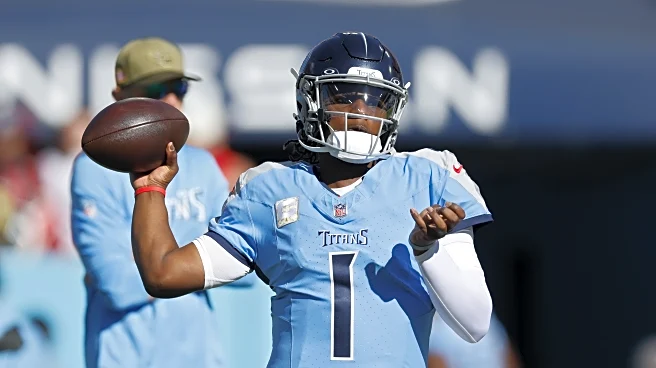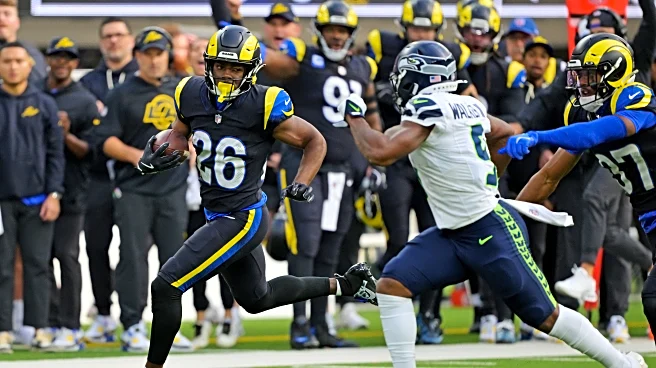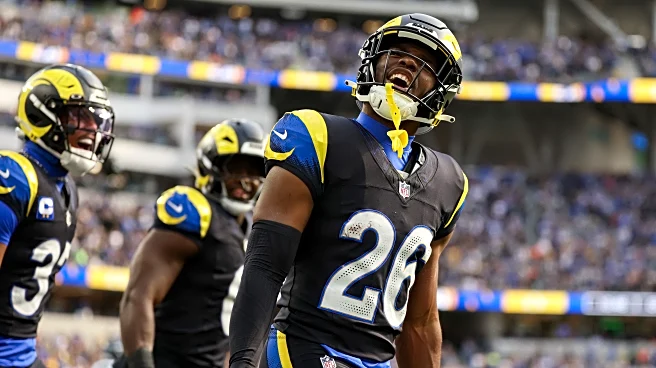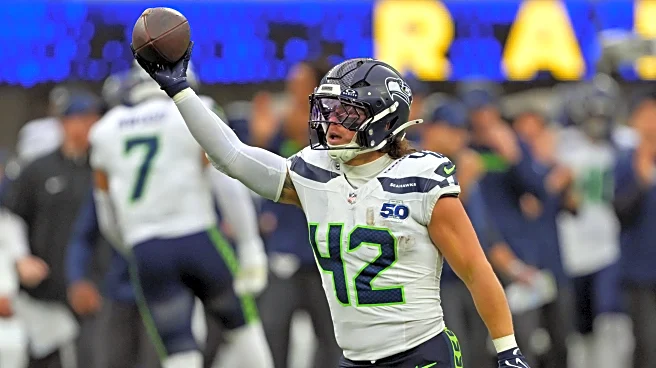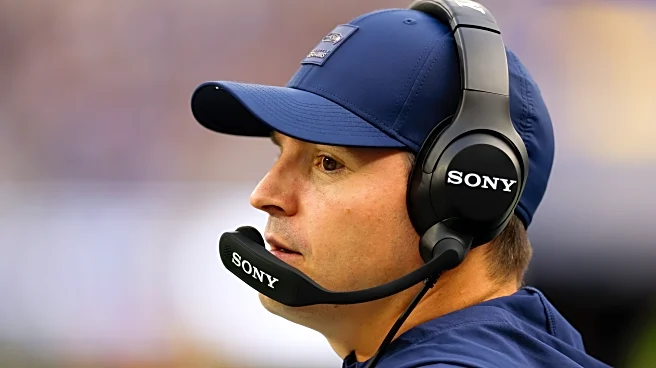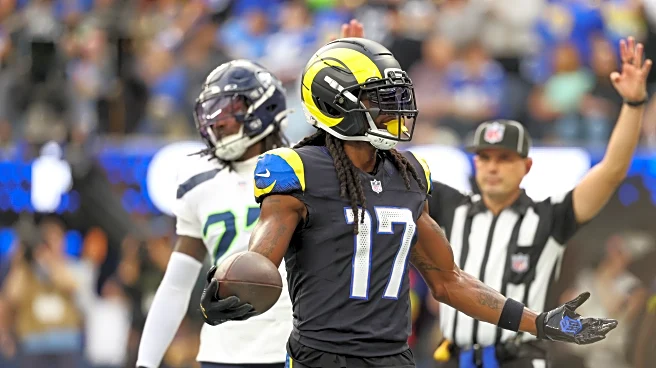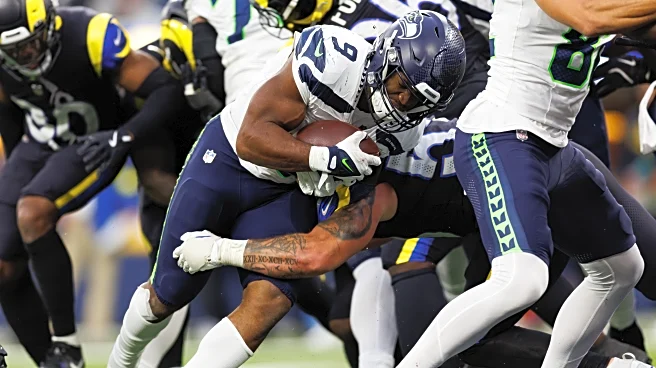In one of the most anticipated games of the year, the Los Angeles Rams put an end to the Seattle Seahawks’ winning streak and even took over the lead in the NFC West. As important as the matchup was, Sam
Darnold did not seem prepared for the challenge and committed four turnovers.
The loss creates an anticlimax for some projections about the remainder of the season, but it’s important to remember that despite the four turnovers, the Seahawks still had a chance to beat one of the best teams in the league. The team must stop stumbling in these matchups against tough opponents — such as the fumble against the 49ers, the interception against the Bucs, and now the four turnovers against the Rams. These mistakes must be corrected if we want to envision a strong postseason for Seattle.
All data used in this article was taken from PFF.
The Bad
A big problem with the OL
The season isn’t even over yet and the Seahawks already have a clear picture of their biggest needs for next year: center and right guard must receive significant investment. Even though the OL features good pieces like Charles Cross, Grey Zabel, and Abe Lucas, at many moments they simply don’t fit together — especially in the run game.
It’s worth noting that the Rams’ defense, coached by Chris Shula, lines up in dime more often than any other team in the league. Against Seattle, they increased those numbers even further, forcing the Seahawks to run the football. Even surpassing 100 rushing yards, finding consistency continues to be an issue for this ground game. And certainly, from now on, defenses will likely adjust in similar ways to limit the Seahawks’ offense, reducing their play-action attempts — just as the Rams did (only 9 PA passes).
Anchor and play strength continue to be problems for Charles Cross in his fourth year in the league. He cannot withstand Jared Verse’s speed-to-power and is driven backward, even contributing to Grey Zabel’s knee injury.
As mentioned in last week’s article, Olu Oluwatimi could be an upgrade (even if a small one) over Jalen Sundell. I don’t believe Sundell has been significantly better than Oluwatimi, but it’s clear that center is one of the team’s biggest needs. In this play, he is completely dominated on leverage by Poona Ford and becomes unable to react, giving up the tackle.
Anthony Bradford playing poorly is nothing new, as he was beaten on two stunts that resulted in Darnold interceptions. But this was unquestionably Zabel’s worst game of the year. He appeared on the injury report with a heel injury, and it clearly limited his mobility — as seen on the previous play. On another snap, both guards misjudge their angles at the second level and give up the tackle to both ILBs.
Christian Haynes has been named Zabel’s replacement until the rookie recovers. It’s worth remembering that Haynes failed to beat Bradford for the starting job. On this play, the Rams — correctly — line up their best pass rusher, Verse, against Haynes, who had just entered after Zabel’s injury. Even though he ends the snap on the ground, Verse wins easily, pushing Haynes into Darnold and forcing the QB to move inside the pocket.
Sam Darnold can’t play against the Rams?
Against the Rams, Darnold was sacked nine times in his playoff start with the Minnesota Vikings. It seems like he traded sacks for interceptions, committing four turnovers in the game. Two of them resulted in touchdown drives for Los Angeles, and another took Seattle out of field-goal range.
But it wasn’t just the interceptions that explain his poor performance. Darnold was slower in his progressions and got stuck on reads in a way much more reminiscent of his 2024 version than the improved 2025 version.
On the play below, even though the Rams have the advantage to defend the first down, Darnold still could have put Seattle in a much more manageable position. Rashid Shaheed runs a slant with complete inside leverage, but Darnold holds the ball longer than he should and throws it behind the receiver, trying to avoid the safety. The bad timing also disrupts the catch point.
Shaheed, by the way, showed in this game that he can be more than just a gadget player. His release is excellent and the cornerback has no chance. This is a touchdown 9 out of 10 times. Without taking credit away from the defender, the pass was underthrown and cost Shaheed his first touchdown of the game.
Now, the painful interceptions:
First INT:
Darnold locks onto Cooper Kupp for the entire play. He doesn’t even notice JSN open deep on the opposite side. Throwing to Kupp wouldn’t have been a bad decision if the QB hadn’t stared him down the whole time, allowing the robber to read his eyes and jump the route. His dropback ends long before the route break, he holds the ball, pressure arrives, and he throws without a base. Everything contributes to the safety Kamren Kinchens making the interception.
Second INT:
Darnold once again fails to make any progression. He locks onto JSN, who doesn’t win the route, and still forces the throw. The pressure — caused by a stunt that Lucas/Bradford failed to pick up — affects accuracy, but even so, there was no throwing lane.
Third INT:
Kinchens appears to be bracketing JSN, as he did several times earlier. The corner slows down the WR, which lets the safety turn his eyes back to the QB. Darnold stays locked onto that side and never looks at the levels concept on the opposite side, which was far more promising. Elijah Arroyo could have executed a better release? Yes. But even so, Darnold’s decision was terrible.
Fourth INT:
Another well-executed stunt by the Rams humiliates Bradford, who ends up turned toward his own quarterback. Darnold initially escapes, but then forces a throw to Arroyo, who wasn’t expecting it and was already slowing down. The pre-snap read was correct, but he hesitated, threw late, and the play resulted in yet another interception.
The Good
Defense was a bright spot
You can argue that the Rams’ offense wasn’t playing at full strength because they were ahead. I don’t dismiss that idea, but it’s important to remember that even in similar situations they put 42 points on the 49ers.
The Rams’ run game is extremely strong. Their offensive line imposes physical dominance with Steve Avila and Kevin Dotson, and the details Sean McVay adds to each run concept turn a simple inside zone into something far more layered.
Seattle allowed two explosive runs of 30 and 34 yards. If you remove those from the box score, the Rams would have run 20 times for 55 yards — an average of 2.75. One of them came from a positioning mistake that created a huge gap between the LT and TE, combined with a missed safety tackle.
This play is an example of how promising Seattle’s run defense can be: Emmanwori seals the edge; Derick Hall defeats the RT and forces the RB to redirect; inside, a stunt between the DTs allows Leonard Williams to destroy both the center and the guard, creating a clear path for him and Murphy.
The Seahawks responded well to the Rams’ 13 personnel. Even in nickel, they used a 6-1 front to reduce the impact of double-teams. Coby Bryant missed some important tackles in this game, but on this snap he executes a great one. Ernest Jones reacts quickly to the possible play-action — a clear result of thorough tape study.
More frustrating than the four Darnold interceptions was giving up a touchdown on fourth down after several outstanding goal-line snaps. Murphy penetrates the backfield immediately, still keeping an eye on the fake. The RB has only one path, but Nwosu sheds the TE block and finishes the play.
I personally didn’t believe Nwosu would be able to contribute this year after consecutive injuries. I’m glad to be wrong. He remains a leader on this defense and played one of his best games against the Rams, far beyond what the box score shows.
The secondary also deserves praise. At around six seconds on the play, look at the Rams’ options: Woolen, Jobe, Witherspoon, Emmanwori — all are in tight coverage. That gives time for the four-man rush to get home with Lawrence, and Stafford misses the checkdown.
Once again, the secondary and defensive linemen are connected. The pressure comes quickly with Lawrence, so even with quick passing concepts and Riq Woolen’s good coverage on Davante Adams, and the clearout options with Josh Jobe and Devon Witherspoon, they were covered.
Remember: this defense was without Jarran Reed, without Julian Love, and with Ernest Jones clearly not at 100%.
Final Thoughts
There’s a saying in Brazil — and there’s probably something similar in the U.S. — that goes: “You can see the glass as half full or half empty.” I think that perfectly summarizes the Seahawks’ performance.
While the team continues to struggle against true contenders (last year they beat only two teams above .500) and often finds new ways to lose, this time it was the turnovers that derailed the game. If against the Bucs the depleted defense had no answers, against the Rams the offense committed four turnovers, reached the red zone three times, and settled for field goals.
The defense managed to contain one of the league’s best offenses. Of the 21 points allowed, 14 came from short fields created by Darnold’s turnovers — two drives that combined for fewer than 30 total yards. Despite giving up two explosive runs, the run defense adjusted well throughout the game. And, finally, the Seahawks still had a chance to win on an extremely difficult field goal — but the opportunity was there, even if Jason Myers’ kick sailed off target as soon as it left his foot.
Go Hawks!
